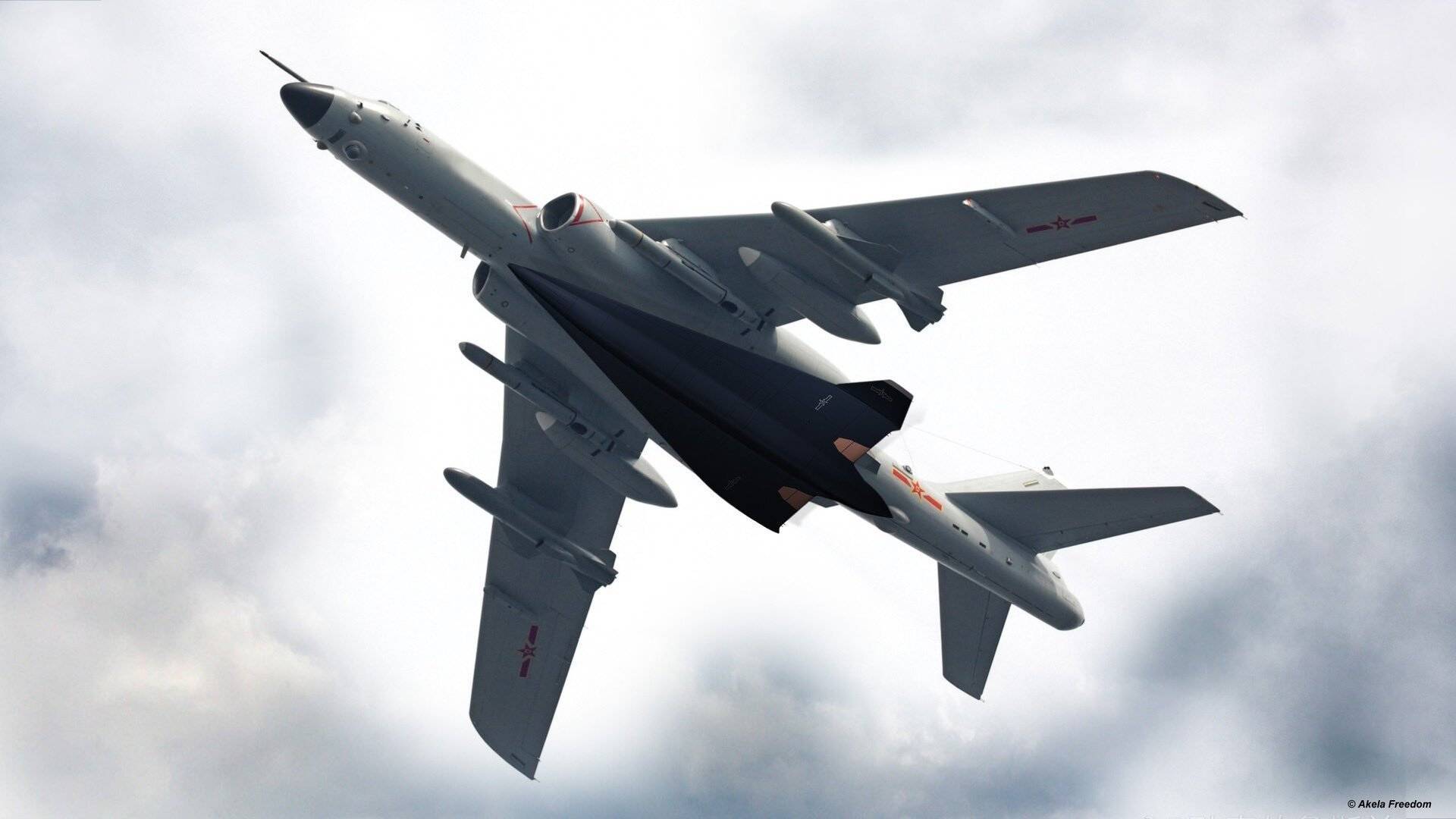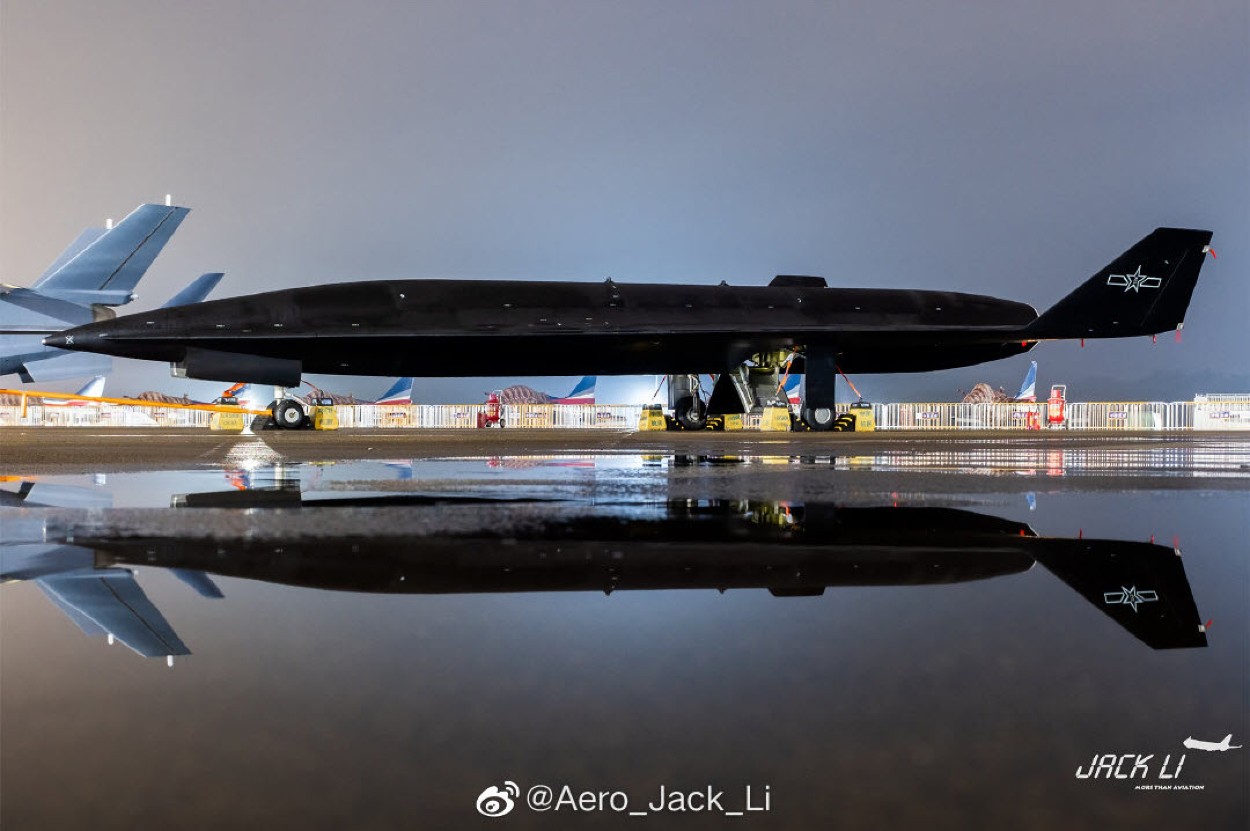An image showing China’s H-6 strategic bomber flying with a WZ-8 supersonic drone strapped to its belly has emerged on social media.
Observers reporting open-source intelligence (OSINT) and People’s Liberation Army (PLA) defense technology believe the image, although grainy, confirms a long-held assessment about the bomber and the drone being paired in the future.
The photo, which first appeared on the Chinese social media platform ‘Weibo,’ showed a contour of an additional pair of delta wings outside the silhouette of the H-6.
It is not known whether this was part of a testing routine, checking carriage, release or launch trials, or an operational exercise. However, it has brought into focus the assessments from various quarters that surprisingly converge on how the drone would be used.
The Chinese H-6 bomber aircraft is equipped with the WZ-8, a high-altitude, high-speed reconnaissance drone. This drone is designed to gather intelligence, conduct surveillance, and potentially guide missile strikes.
🇨🇳 pic.twitter.com/qh4Mhk4tWH— International Defence Analysis (@Defence_IDA) April 19, 2024
Design Characteristics
The WZ-8 high-speed drone was first unveiled at the National Day military parade in October 2019, where analysts also noted interesting details in close-up shots.
Ankit Panda, Senior Fellow at the Carnegie Endowment for International Peace, brought attention to the suspension lugs (for bomber mounting on the H-6), front section, forward landing gear, aft section, showing the rocket nozzle-shaped exhaust, and delta-wing configuration with the tips raised into vertical stabilizers.
The rudders on the vertical stabilizers also showed antennae jutting out, which can be assumed were meant for transmitting radio for guidance control post-launch. China is well aware of the advances in electronic warfare (EW) displayed in the Russia-Ukraine war and the lessons prime strategic rival US itself has taken.
How Will It Be Used?
The drone can be assumed to be at least semi-autonomous — if not fully autonomous and free of manual control — in a significant section of its mission profile. This would be while performing high-speed reconnaissance overflight gathering either optical or electromagnetic data of the battlespace.
The nozzle design is a classic rocket exhaust, seen in the Russian Soyuz, Angara, American Delta, Atlas, Saturn, or even NASA’s Space Shuttle. The overall aerodynamically stable shape, besides the nozzle, indicates the aircraft is meant less for maneuverability and more for high-speed runs.
This kinematic feature is also seen in other high-speed photo reconnaissance aircraft, like the Russian MiG-25 Foxbat used by the Indian Air Force (IAF) and the US’s Cold War-era SR-71 Blackbird.
Broadly, an operational procedure might involve the WZ-8 flying along waypoints and directions preset on the ground over a general battlespace, activating its sensors (possibly electronic and optical), flying back, and landing autonomously.
The WZ-8 and the WZ-7 Soaring Dragon will be employed when the People’s Liberation Army (PLA) commanders want to ‘sweep’ a battlespace of all electronic and radar data.
They can create a general target picture to initiate long-range, standoff anti-ship and land-attack fires. It can be concluded that the drones would be flown before the commencement of any operations.
‘China Wants Reconnaissance & Surveillance Lead’
The Washington Post’s (WaPo) April 2023 report on leaked documents from the online group Discord about Chinese military drones, particularly the WZ-8, validates the above analysis. The report touches upon the H6-WZ8 pairing, nearly a year after which the same plane is seen with the drone in its undercarriage.
“The twin-engine H6-M Badger bomber (will be) used to launch it. After taking off from its home air base, the warplane would fly just off China’s east coast before releasing the stealthy drone, which could then enter Taiwanese or South Korean airspace at a height of 100,000 feet and fly three times the speed of sound.”
The document does not detail how the drone is propelled but says, “engine features are primarily associated with rocket fuel.”
Another picture that appeared in May 2023 showed the WZ-8 with two boosters (one on each side). Possibly propelled by solid fuel, the booster configuration might evolve into an alternative launching mechanism, accelerating the WZ-8 to cruising speeds before being jettisoned.

Besides “electro-optical cameras and sensors” for gathering “intelligence on Taiwan’s main island and the western side of South Korea, including Seoul, the use of Synthetic Aperture Radar (SAR) would allow it to map territory at night and foggy weather,” the WaPo report stated.
WaPo quoted the director of the aeronautical systems research division at the National Chung-Shan Institute of Science and Technology (NCIST), Chi Li-pin, who said the “drone’s primary use won’t be against Taiwan but against the United States and its military bases in the Pacific…It’s a weapon for anti-access and area denial,” he said.
Chi added that the aircraft did not appear to be designed to launch attacks but could be modified for the purpose. “It is difficult to detect and intercept. The existing US air-to-air weapons aren’t good enough,” he said. Other experts noted that even Japan and India should “worry about it.”
Ironically, India, too, boasts about supersonic speed platforms that are invulnerable to air defenses when it advertises the Mach 3-plus speeds of the Indo-Russian BrahMos (a derivative of Moscow’s P-800 Onyx) land and ship-strike cruise missile. Indian planners, therefore, know the value of such weapons all too well.
An inherent dilemma for adversaries, even if they detect the WZ-8, would be whether to rearrange their battlefield assets—a tedious and time-consuming process. Even if they take such an option, it would risk detection-friendly movements and radio communications that can be picked up by Chinese satellites and electronic snooping.

‘Intelligentized Warfare’
The report noted the Chinese aim was to strengthen its “surveillance” and “reconnaissance” capabilities, to “find” and “hit the enemy.” At a broader doctrinal level, it was consistent with the PLA’s “intelligentized warfare,” which placed knowledge of the battlespace, resilient “kill chains,” and enhanced situational awareness over core combat power.
Possibly, after launching the WZ-8, the H-6’s ‘K’ variants (H-6K) might take off in a squadron of 18 to 20, armed with YJ-12 anti-ship cruise missiles, or KD-20, CJ-10K, and CJ-20 land-attack cruise missiles swarming a naval armada or an island with over 100 projectiles speeding toward them.
The WZ-8 and the H-6 would be China’s attempt to have the most number of ‘eyes’ in the sky.
- The author can be reached at satamp@gmail.com
- Follow EurAsian Times on Google News




